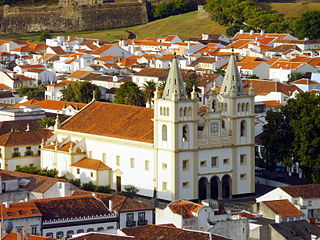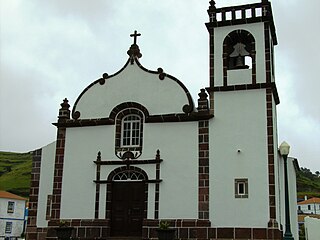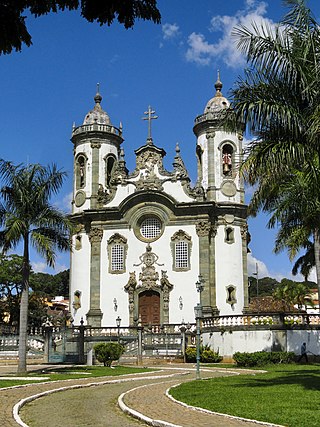
Chaves is a city and a municipality in the north of Portugal. It is 10 km south of the Spanish border and 22 km south of Verín (Spain). The population of the entire municipality in 2011 was 41,243, in an area of 591.23 km2. The municipality is the second most populous of the district of Vila Real. With origins in the Roman civitas Aquæ Flaviæ, Chaves has developed into a regional center. The urban area or city proper has 17,535 residents (2001).

Penafiel is a municipality and former bishopric in the northern Portuguese district of Porto. Capital of the Tâmega Subregion, the population was 72,265 in 2011, in an area of 212.24 square kilometres (81.95 sq mi).
São João de Areias is a Portuguese civil parish in the municipality (concelho) of Santa Comba Dão, in the former-district of Viseu. The population in 2011 was 1,939, in an area of 21.51 km2.

Januária is a municipality in northern Minas Gerais state, Brazil. It is located on the left bank of the São Francisco River. The population was 67,852 inhabitants and the area of the municipality was 6,691 km2 (2007).
The name Boni Homines or Bonshommes was popularly given to at least three religious orders in the Catholic Church:

The Diocese of Porto (Oporto) is a Latin Church diocese of the Catholic Church in Portugal. It is a suffragan of the archdiocese of Braga. Its see at Porto is in the Norte region, and the second largest city in Portugal.
The Brothers of Penitence or Friars of the Sack were an Augustinian community also known as Boni Homines or Bonshommes, with houses in Spain, France and England.

Miguel António de Melo, a nobleman, colonial administrator and the 1st Count of Murça. He was young nobleman who exercised a position in the Royal court of Portugal, 14th Lord of Murça and Castro Daire, squire of Figueira, commander of Santa Maria de Freixas in the Order of Christ and honorary member of the Royal Academy of Sciences, in addition to holding several political offices, including that of governor and captain-general of Angola, minister and peer of the realm, appointed to a commission, by King John VI of Portugal, to draft a constitution for Portugal, minister and peer of the realm.

The Diocese of Angra is a Latin Church diocese of the Catholic church in the Portuguese archipelago of the Azores. The see is located in Angra do Heroísmo, in the Terceira island. The current Ordinary is Armando Esteves Domingues.

The Diocese of Viseu is a Latin Church diocese of the Catholic church in Portugal. It is a suffragan of the archdiocese of Braga. Its episcopal seat is in Viseu Cathedral in the Centro Region. The current bishop is António Luciano dos Santos Costa.
Diogo das Chagas, O.F.M. ; was a Portuguese Franciscan friar and historian. He is best known as the author of Espelho Cristalino em Jardim de Várias Flores, an important resource on the colonization of the islands of the central and western groups of the Portuguese archipelago of his native region of the Azores after 1640.

The Hermitage of Nossa Senhora dos Anjos, is a hermitage/chapel located in the village of Anjos, on the northcoast of the civil parish of Vila do Porto, on the island of Santa Maria in the Portuguese Azores.

The Cathedral of Angra do Heroísmo is a Portuguese 16th-century cathedral located in the civil parish of Sé, in the municipality of Angra do Heroísmo, on the island of Terceira in the archipelago of the Azores.
The Canons Regular of San Giorgio in Alga were a congregation of canons regular which was influential in the reform movement of monastic life in northern Italy during the 15th and 16th centuries.

The Church of Santa Bárbara is a Roman Catholic church in the civil parish of Santa Bárbara, municipality of Vila do Porto, in the archipelago of the Azores. Located in the valley of the same name, the parochial church of Santa Bárbara was constructed sometime in the early 15th century and served the impoverished parish throughout its history, supported by personal donations and community assistance.
The Convent of Beato António is a former Portuguese convent, located in the civil parish of Beato, in the municipality of Lisbon.

Alexandre da Sagrada Família, born Alexandre José da Silva, was the 25th Bishop of Angra, governing between 1816 until his death in 1818. The first Bishop born in the Azores, known as a poet, he was the paternal uncle of Almeida Garrett, and stayed with his parents when he visited Terceira.

The Royal and Venerable Confraternity of the Most Blessed Sacrament of Mafra, alternatively, the Royal and Venerable Brotherhood of the Most Blessed Sacrament of Mafra, is a public association of faithful of the Catholic Church, canonically established in the Basilica of Our Lady and Saint Anthony of Mafra, Portugal.

The Church of Saint Francis of Assisi is a Catholic temple founded by the Secular Franciscan Order in the Brazilian city of São João del-Rei, in the state of Minas Gerais. The church, started in 1774, is one of the main landmarks of Brazilian colonial art, becoming famous for the beauty of its architecture, the richness of its carving, and the work of Aleijadinho, later modified by Francisco Cerqueira. Due to its importance, the church was declared a national heritage site by the National Historic and Artistic Heritage Institute (IPHAN) along with its entire collection.











